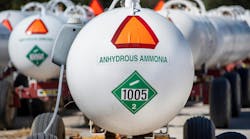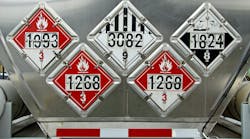The Federal Motor Carrier Safety Administration is making changes to the Department of Transportation Hazardous Materials Safety Permit (HMSP) program called for under the Moving Ahead for Progress in the 21st Century Act (MAP-21). The changes take effect August 18.
The changes are being implemented under the existing Safety Fitness Procedure regulations. FMCSA will use SMS scores to provide enhanced oversight of HMSP holders, to identify poor-performing carriers for a safety fitness compliance review, and to provide grounds for suspension or revocation. Both of these processes afford the motor carrier the right to administrative review and the opportunity to present corrective action.
On December 16, 2014, Congress passed the 2015 Omnibus Appropriations law entitled, “Consolidated and Further Continuing Appropriations Act, 2015,” which restricts FMCSA's use of appropriated funds “to deny an application to renew a Hazardous Materials Safety Program permit for a motor carrier based on that carrier's Hazardous Materials Out-of-Service rate, unless the carrier has the opportunity to submit a written description of corrective actions taken, and other documentation the carrier wishes the Secretary to consider, including submitting a corrective action plan, and the Secretary determines the actions or plan is insufficient to address the safety concerns that resulted in that Hazardous Materials Out-of-Service rate.”
By using SMS scores to identify a HMSP holder for a safety fitness review, the agency, while complying with this congressional limitation, will ensure that transportation of the hazardous materials specified in 49 CFR 385.403 does not present an undue safety risk to the public, according to FMCSA officials.
FMCSA will now differentiate the requirements for issuance of an initial HMSP as specified in 49 CFR 385.407, from the requirements for HMSP renewal, as specified in 49 CFR 385.419. Distinguishing these requirements, as discussed below, enables the agency to more actively monitor an HMSP holder's safety and compliance status, while providing more flexibility to HMSP holders attempting to correct identified deficiencies.
Pursuant to the 2015 spending restriction, the agency is no longer denying HMSP renewals based on a carrier's unacceptable hazardous materials out-of-service rate. Upon the effective date of this notice, the Agency will no longer deny a HMSP holder's application for renewal of its HMSP based on a crash rate, driver, vehicle, hazardous material or total out-of-service rate that is in the top, or worst-performing, 30% of the national average.
New applicants for HMSPs, which includes any applicant that is not a current HMSP holder, and holders of temporary HMSPs (T-HMSP) will continue to be subject to the established crash, driver, vehicle, hazardous material, or total out-of-service threshold rates in order to qualify for the initial issuance of an HMSP. The requirement that new applicants not have a crash rate or a driver, vehicle, hazardous material, or total out-of-service (OOS) rate for the prior 12 months, as shown below, remains unchanged:
a. A crash rate in the “top 30% of the national average,” or
b. A driver, vehicle, hazardous material, or total out-of-service (OOS) rate in the “top 30% of the national average.”
However, non-temporary HMSP holders will no longer be required to have crash and OOS rates that are below the “30% threshold” at the time of the HMSP holder's two-year renewal. Rather, FMCSA will continually monitor these HMSP holders using SMS analysis as a basis for a compliance review referral or proposed revocation or suspension based on the criteria listed in 49 CFR 385.421. HMSP holders will continue to be subject to the renewal provisions in 49 CFR 385.419, which require the carrier to submit its biennial update.
The first recommendation in the HMSP Report to Congress was for FMCSA to fully utilize the Agency's SMS to provide continuous monitoring of HMSP holders' safety performance in order to determine a carrier's continuing suitability to retain or renew a non-temporary HMSP. Carriers applying for a six-month T-HMSP will be subject to the requirements for initial issuance of a HMSP in Section 385.407.
Temporary HMSPs are issued when a motor carrier meets all of the qualifications in Section 385.407 except for having a safety rating assigned. If the carrier has no safety rating, the T-HMSP is issued, and the motor carrier is assigned for a comprehensive investigation within six months of the FMCSA field staff being notified. FMCSA may extend the T-HMSP for two months, when necessary due to the Agency's inability to schedule a comprehensive investigation during the initial six-month timeframe.
Once the carrier receives a comprehensive investigation, and subsequently is assigned a satisfactory safety rating, the carrier is eligible for a full, non-temporary HMSP subject to the initial requirements in Section 385.407. Once the non-temporary HMSP is issued, the agency will place the carrier under the continuous monitoring program.
Non-temporary HMSP carriers will continue to be subject to the current intervention thresholds for all carriers of placarded hazardous material under the seven Behavior Analysis and Safety Improvement Categories (BASIC) in SMS. These intervention thresholds are listed below:
60th percentile for Unsafe Driving, Hours of Service Compliance, and Crash Indicator;
75th percentile for Driver Fitness, Controlled Substances/Alcohol, and Vehicle Maintenance; and
80th percentile for Hazardous Material Compliance.
For carriers that have a non-temporary HMSP, FMCSA will review the permit holder's SMS scores monthly to determine if the carrier has met or exceeded intervention thresholds for either the Hazardous Materials Compliance BASIC (HM BASIC) or met or exceeded thresholds for any two of the other BASICs for the preceding two consecutive months.
If the carrier meets or exceeds the HM BASIC or meets or exceeds thresholds of any other two BASICs over a consecutive two-month period, FMCSA will identify the carrier for investigation with hazardous material compliance emphasis. Using the monthly data provides a more powerful tool for identifying the HMSP carriers that have overall compliance problems, warranting a comprehensive investigation, or issues in one particular area of safety performance (ie, crash rate, driver, vehicle, or hazardous material). A comprehensive investigation will entail a full-rated review that will also determine whether the carrier meets the safety fitness requirement in 49 CFR 385.421(a)(3).
The SMS approach provides a strengthened, continuous monitoring process for HMSP holders, which merit heightened oversight and monitoring due to the dangerous nature of the materials they transport. SMS monitoring further allows the agency to expeditiously identify carrier problems and better focus on specific areas that the carrier must address immediately, in order to avoid potential suspension or revocation of its HMSP under 49 CFR 385.421(a).
If a carrier fails to comply with the applicable regulations, or an order issued under those regulations, indicating that the carrier is not fit to transport hazardous material that requires a HMSP, such conduct could similarly trigger a proposed suspension or revocation under Section 385.421(a)(5),(6),(7), (8), or (10). It should be noted that a proposed suspension or revocation under 385.421(a)(5) would be based on serious instances of non-compliance, a less than satisfactory safety rating, or loss of operating authority. The proposed suspension or revocation would be subject to the 30-day notice requirement in Section 385.421(c)(2), and the carrier would have an opportunity to take corrective action and/or to apply for administrative review under Section 385.423 before FMCSA took final action.
If a carrier's non-temporary HMSP is denied, suspended, or revoked pursuant to Section 385.421, the carrier will have various options for seeking administrative review and providing evidence of corrective action. If the suspension or revocation is based on a less than satisfactory safety rating, the carrier may request administrative review of the proposed rating under Section 385.15, or may request upgrade of a proposed safety rating based on corrective action under Section 385.17, as provided in Section 385.423(a). The carrier may seek administrative review of other grounds for a proposed suspension or revocation as provided in Section 385.423(c).
A proposed suspension or revocation under Section 385.421(c)(2) will not become effective during the pendency of a request for administrative review that is timely-filed during the 30-day timeframe from the date of service of the written notice of proposed suspension or revocation. The 30-day effective date and the tolling of this date by a request for administrative review of proposed suspensions or revocations that are not related to a less than satisfactory safety rating allows the carrier time to take and submit evidence of corrective action.
The second recommendation in the HMSP Report to Congress was for FMCSA to institute an ongoing requirement to more closely monitor HMSP carriers with insufficient SMS data--that is, HMSP carriers that rarely undergo roadside inspections and have a safety rating over four years old. Because of the lack of information and oversight on these carriers, FMCSA will conduct comprehensive investigations for HMSP carriers when the carrier has insufficient data to calculate a percentile in SMS during any month of the previous 48-month period.
HMSP carriers will not be allowed to operate for more than four years without either having enough safety performance data to confirm compliance, or having received a compliance review that results in a satisfactory rating. By instituting a specific four-year investigation cycle for non-temporary HMSP carriers with insufficient safety data, these carriers will become subject to increased oversight. ♦









